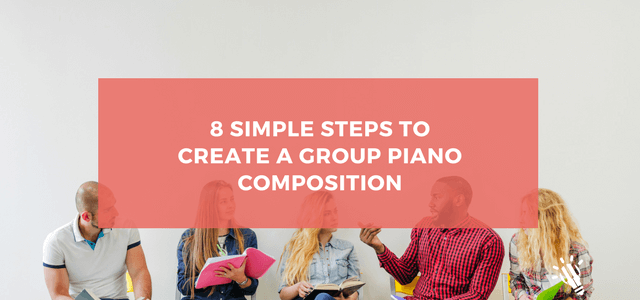Before we wrap up our piano composition month and head into September’s theme of group teaching, why not combine the two topics?
We are so privileged to welcome guest writer Wendy Brentnall-Wood to show us exactly how you can organise a group piano composition.
Wendy is a music teacher and examiner, a published author and a speaker, and founded Wendy’s Music School. She is full of experience, knowledge and wisdom and we cannot wait to learn from her. Take it away, Wendy!
Can you imagine taking on the challenge of creating a group piano composition that every student in your studio and some parents contribute to?
Well, crazily enough that’s exactly what I chose to try for the first time earlier this year.
It all started with my decision to move out of my comfort zone and choose a unique theme for one of my studio concerts: Originals and Improvisation. As a classically trained musician, this was a great challenge!
Having chosen Originals and Improvisation as a theme, my next challenge was to inspire and encourage my students to take up the challenge and participate.
My beginning students have the opportunity to be creative in short activities, but nothing really suitable to perform at a live concert. I knew that with such a different theme my intermediate, advanced and adult students would need confidence boosts in performing an improvisation activity live or creating their own composition.
So, instead of putting my students out there by themselves for the first time, I took a different approach.
We started with a group piano composition. During individual lessons, I would work with each of my students on developing either a composition or a planned improvisation, depending upon which they preferred.
Need some creative ideas for your next piano studio recital? Check out this expert roundup: How to Organise Fun Piano Recitals
Term 2 begins this year and each student bounces into the room and takes up their seat on the piano stool ready to resume lessons as normal.
But instead of a ‘normal’ piano lesson, I surprised my students. Here’s how the conversation went:
Wendy: So you know we have another concert opportunity at the end of this term coming up?
(Student nods unconcerned)
Wendy: Well this time we’ve got a bit of a different theme…….
(Student still unconcerned )…..
Wendy: We’re doing Originals and Improvisations. Do you know what that means?
(Student’s eyes have become wide and they are now sitting up very straight looking slightly panicked!)
We discuss the difference between composing original music and improvising and the student still looks worried about what they are going to be expected to do.
Wendy: So we’re going to start with a group piano composition……
(Student frowns, wondering how that will work when they never see most of the other students except at concerts)
Wendy: Can you see the large piece of paper stuck on the back of the studio door? Well, it has the lyrics/words of the song Imagine by John Lennon from the Beatles. We are going to use that song as a structure to start writing our own song, one little piece at a time! Do you want to know how we’ll starrt?
(Student obliging nods head)……
Wendy: OK Great- let’s listen to the original song, following the words in black on the paper first.
Wendy: You can see under the first word Imagine in black I’ve written a word in pink. This means I’ve changed the first word, imagine, (also the name of the song) to the word “Creating”. That’s going to be our theme for this song!
Wendy: Now you get to change the next word!
(Student is unsure how to do this, so we discuss how many syllables, sound out, clap out the rhythm of the word they are changing, and encourage the student to say random words that may fit until they find one they like.)
For younger students, there was an unexpected benefit of parents joining the process and helping their child with word suggestions and reading through the lyrics that were being created.
Related: How to Get Your Beginner Piano Students Composing Music
The results were fabulous, particularly from a community sense!
Students were commenting upon one another’s choices, were excitedly reading what had been done since their last visit, rushing to pick up the pink pen and work out where and what their next word would be, as soon as they entered the studio.
I had each student put their initials under their words so I knew if someone missed out or we needed to make changes, but after the first week I actually didn’t have to give them much help at all- it was fabulous and the excitement was awesome to see.
Concert day saw the whole audience, (not just my students) singing our words to the tune of Imagine and a karaoke backing track from the words projected onto the wall. Here’s the video:
Recommended: Composition Kickstarts: 5 Ways to Inspire Your Students to Write Music
Need help teaching rhythm? Check out this post: 5 Ways to Help Your Students Master Rhythm
I will definitely be doing this activity again next year and highly encourage other studio teachers or classroom teachers to consider using an existing song as a starting point when creating a new or group piano composition.
What other ways do you get your students to compose music in groups? Leave your suggestions in the comments section below.

Marie Lee says:
What a creative idea, Wendy! Such a fun way to build community in your studio. I’m definitely giving this a try. Thanks for sharing 🙂
Wendy says:
It was certainly fun Marie! We all learnt a lot and had many giggles about possible words to add, how words and rhythm work together and I got to introduce the Beatles to another generation!